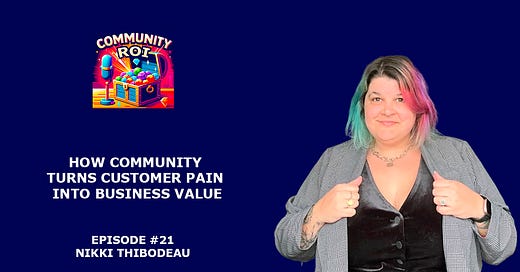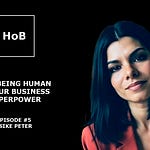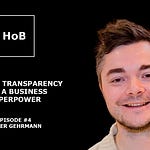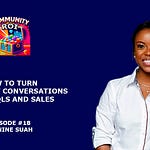“ One of the things that we often try to do is take a look at the community first, and then you try to make it so that the community tells you what it's, what it's giving to you.
That's just not the way it works.
You wanna take a look at what matters to the business and then work backward from there. What are the things that can tell me whether or not, I have product feedback, so like I can work with product or whether I have product adoption or whether I have any community qualified leads. What are the things that the business cares about?
So if the business says to you, I care about case deflection, then you can go work backward and see if that your community has anything to give to that today, but don't try to go from community to business because, you'll just try to make things fit where it doesn't fit.“
From this episode, you'll know:
👉 Why community is “relationships at scale”, not just engagement.
👉 Why trust is the foundation of impactful communities.
👉 How to build programs that solve customer problems and meet business KPIs.
👉 Examples of aligning with marketing, support, and product teams.
👉 How to bring visibility to community value across the company.
Choose the best platform to listen to this episode:
Connect with Nikki and Yurii here:
https://www.linkedin.com/in/nikki2987/
https://www.linkedin.com/in/yurii-lazaruk-community-consultant/
🎙️ The ROI of Trust: How Community Turns Conversations into Business Growth
"Community isn’t just about engagement. It’s about relationships—at scale."
That was one of the first things Nikki said when we hit record. And from that moment on, I knew this conversation wasn’t just about metrics. It was about meaning.
Nikki is an amazing community expert, strategist, and leader. She was Shopify’s first Senior Community Strategist, where she helped scale community efforts across a 10,000+ person organization and for over 2 million merchants. She’s also the founder of the one and only The Community Community—an extra special, safe, and trusted space for senior community builders.
In short: Nikki lives and breathes what it means to connect people in meaningful, business-aligned ways.
But what does that actually look like in practice?
💡 Community Goals vs. Business Goals: Stop Merging Them
We started where most community strategies go wrong: trying to start with community and work backwards to business. Nikki flipped that script right away.
“A community goal should help the customer grow. A business goal helps the business grow. But when they align—you get magic.”
She reminded us that community isn't a silo—it’s a bridge. And the key is to start with what the business is already trying to achieve—whether it’s case deflection, product adoption, or customer retention—and then map community programs to support those goals.
🧱 From Problems to Programs: Solving Real Customer Pain
One of Nikki’s most powerful stories came from her time at Shopify. The team realized many entrepreneurs were getting stuck trying to launch their stores, not because they lacked motivation, but because building websites wasn’t their thing.
“Our goal in the community became helping them go live faster. It wasn’t about features—it was about solving the real pain that was slowing them down.”
That shift—from promoting products to removing barriers—turned the community into a growth driver. Customers launched faster. Churn went down. The community delivered results that the business could see.
🤝 The Power of Asking (Not Assuming)
A recurring theme in our conversation was this: community pros don’t guess. They ask.
“You’re not making assumptions. You’re actually asking. And often, people don’t even want you to solve their problem—they want to be heard.”
That simple truth leads to smarter programs. At one company, Nikki and her team created a “Champions Cache”—a pre-launch customer feedback group that shaped content and programs before they went public. That feedback loop didn’t just build better initiatives—it built trust.
🧠 What Broken Trust Really Looks Like
Of course, not every community starts from sunshine and emojis. Nikki joined a company where the customer community was actively hostile. Distrust was high. Feedback was brutal. But she didn’t run.
“The loudest voices were telling us something: that they still believed they could be heard. That was our starting point.”
They responded by rebuilding transparency. Partnering with technical teams. Sharing product updates publicly. And over time, that broken trust turned into collaboration. One of their harshest critics even emailed recently, saying he wanted to apply their community practices inside his own company.
Let that sink in: community didn't just serve the business. It inspired it.
🔁 Partnering Across the Org: Help Me Help You
Getting internal buy-in can feel like climbing Everest. Nikki’s tip? Start by listening.
“I never start by asking for help. I start by asking: what are you measured on? What are you struggling with? Let’s build something together.”
This is how she’s generated marketing leads, collected customer stories, and co-created product content—all through community. One campaign even turned a fun community raffle into 9 qualified customer stories.
That’s not fluff. That’s business value in the customers’ own words.
📉 When “Less Activity” Is a Win
One moment really stood out to me. Nikki explained that once trust and transparency improved in their community, engagement metrics dropped—and that was a good thing.
“People weren’t coming in to complain anymore. They had what they needed. Less noise meant more trust.”
It’s a reminder that not every dip in activity is a red flag. In some cases, it means your community is doing its job quietly and effectively.
🧭 So, How Do You Prove ROI?
This was Nikki’s final and perhaps most practical takeaway:
“Start with the business. If they care about case deflection, go find where your community supports that. Don’t make things fit. Find what already fits.”
She shared how her team tested assumptions, benchmarked against industry metrics, and built a case for community ROI grounded in data and feedback. The result? A clear, credible story the C-suite could actually understand.
🏁 Final Thoughts
Community is often seen as a “soft” function. But as Nikki shows, when you lead with listening, measure what matters, and anchor in trust, community becomes one of the most strategic levers a company can pull.
It drives loyalty. Reduces costs. Inspires innovation.
And most importantly, it makes your business more human.
If you're building or scaling a community today, start with one simple question:
“What does my business care about most?”
Then, work backwards, and bring your community with you.
🙋♀️ Want More?
You can connect with Nikki on LinkedIn and explore The Community Community — a trusted space she founded for senior community builders to learn, share, and grow together 💛















Share this post